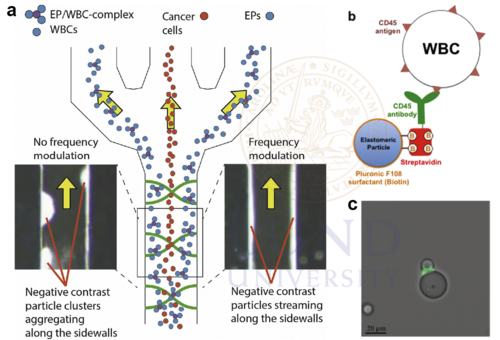Binary separation
The acoustic contrast factor
Depending on their acoustophysical properties, particles migrate to the pressure node or the anti-node in the standing wave field. The acoustic contrast factor, Φ(ρ, κ), which comprises densities and compressibilities of the particle and the carrier medium, governs the direction of the movement.

Most rigid particles migrate to the pressure node while air bubbles and lipid particles go to the anti-node. If two particles have different sign of the contrast factor will make separation of them very easy as the will relocate into spatially distinctive positions half a wavelength a part. This was utilized by Petersson et al. (2004) and Jönsson et al. (2004) in an application where whole blood was purged from lipid vesicles.

Cushing et al. used polymer particles with negative contrast factor in order to separate white blood cells from a circulating tumor cell sample by coating the polymer particles with affinity ligands so that the WBCs bind to the polymer particles. This causes the normally positive contrast WBCs to become negative when they bind to the polymer particles as thus enabling an efficient binary separation.

References
Petersson F. et al., Separation of lipids from blood utilizing ultrasonic standing waves in microfluidic channels, Analyst, 2004, 129, 938-943
Jönsson H. et al., Particle Separation Using Ultrasound Can Radically Reduce Embolic Load to Brain After Cardiac Surgery, Annals of Thoracic Surgery, 2004, 78, 1572–1578
Petersson F. et al., Continuous separation of lipid particles from erythrocytes by means of laminar flow and acoustic standing wave forces, Lab on a chip, 2005, 5, 20-22
Cushing K. et al., Reducing WBC background in cancer cell separation products by negative acoustic contrast particle immuno-acoustophoresis, Analytica Chimica Acta, 2018, 1000, 256e264
